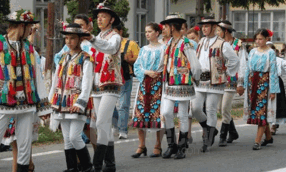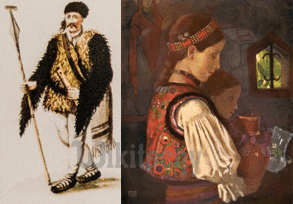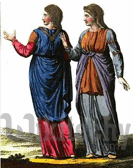Romania Interview Outfits
Romania Details
- Romania people - Romanian
- Romania capital / capital of Romania - Bucharest
- Romania language - Romanian
- Romania population / population of Romania - 2015 estimate 19,511,000
- Romania currency - Romanian leu (RON)
ROMANIA DRESS CODE
- Romanians consider themselves as trustful business partners and they are very serious when speaking about business.
- They are professionals; many of them are holding MBA degrees in prestigious universities abroad.
- They are aware of the international business practice and they are studying the particularities of the potential partner before first meeting.
- Romanian business men pay respect to the foreign partners and expect to be treated in the same way.
ROMANIA DRESS CODE FOR JOB INTERVIEWS
- It is important to demonstrate at an interview good appearance as well as good manners.
- Dress neatly and formally.
- romanian women may wear dresses or skirts and blouses.
- Suits and ties are appropriate for romanian men.
- Caps, bandannas, athletic shoes, sweats, unkempt clothes, jeans, singlets, open shoes and thongs are never acceptable.
- If the wind was blowing, comb your hair before making first contact at the reception. Do not carry a water bottle or coffee mug.
- Carry only a slim folder holding your job application documents and CVs. Do not eat or chew anything.
BUSINESS DRESS CODE
- The dress code is dictated by the formality of the business meeting.
- For a formal meeting, where business is to be discussed between people that have not met before, it is important to present a highly professional image.
- A conservative style would be most appropriate, in the form of a tailored business suit with elegant tie or accessories.
- For romanian women, skirt length should be at or below the knee and jewellery should be elegant and discreet.
- In a more casual setting, such as a business lunch, outfits can be more relaxed and tend towards the business casual style.
- Casual business attire may include jacket and jeans for romanian men, and a suit skirt and blouse or knee-length dress for romanian women.
- Smart casual would be the most casual form of attire that you would need on a business visit and would mostly be appropriate when sightseeing or dining out in a casual situation.
- For ceremonial or highly prestigious social events, there will be a very specific dress code that must be followed and you should pay attention to the invitation or ask your host, to ensure that you are dressed appropriately.
- In general, it is recommended to avoid wearing flashy colours or outlandish outfits, earrings, hair dyed in striking colours or extreme styles, or excessive use of perfume.
ROMANIAN FOLK COSTUMES

- The structure of Romanian traditional clothing has remained unchanged throughout history and can be traced back to the earliest times.
- The basic garment for both romanian men and women in Romania is a shirt or chemise, which is made from
- hemp,
- linen or
- woolen fabric.
- This was tied round the waist using a fabric belt, narrow for romanian women and wider for romanian men. The cut of this basic chemise is similar for romanian men , romanian women and romanian girls
- famous clothing among romanians are matchless clothing , voulez vous clothing , jamaican colors clothing , romanian baby clothes , wasps rugby clothing , romanian traditional blouse , yong kim clothing , sooty clothes , romanian folk clothing , mike tyson clothing uk , romanian embroidered peasant blouse , petronas clothing
- In the past those worn by romanian women and romanian girls usually reached to the ankles while romanian men shirts were shorter and worn over trousers or leggings made from strips of fabric.
- romanian women & romanian girls always wear an apron over the chemise. This was initially a single piece of cloth wrapped round the lower part of their bodies and secured by a belt at the waist, as is still seen in the east and south east of Romania.
- In Transylvania and the south west of Romania this became two separate aprons, one worn at the back and one at the front.
- Men’s traditional clothing throughout Romania comprises a
- white shirt (cămasă),
- white trousers,
- hat,
- belt,
- waistcoat and or
- overcoat.
- Local differences are indicated by
- shirt length,
- type of embroidery,
- trouser cut,
- hat shape, or
- waistcoat decoration.
- In most areas shirts are worn outside trousers, which is the older style. This is a basic Balkan man’s costume largely uninfluenced by fashions from west or east.
- Hungarian and Saxon men living in Romania wear trousers with a more modern cut often made of dark material rather than white. This reflects their closer ties, and more frequent communication, with the west.
- Most of the apparel companies focussed on the pulse of romanians search related to clothing. Predominant pulse of romanian people are on romanian clothing , coordinates clothing , hba clothing , kuhl clothing , romanian blouse , italian clothing brands , scania clothing , threadbare clothing , streetwise clothing , aztec clothing , raised by wolves clothing , marble clothing , glory boyz clothing , the 1975 clothing , msfts clothing , romania shirt , ness clothing , swamp clothing , history of romania , romanian men , penny's clothes , romanian culture , romanian names , clueless clothes , folk costume , romanian boys , rihanna clothes , transparent clothes , atmosphere clothing , romans clothing
- The outer garments worn by both romanian men and romanian women are similar, the main differences being in cut and decoration which depend mainly on the region of provenance.
- These garments are usually made of sheepskin, or felted woolen fabric, and decorated with leather applique and silk embroidery.
- Traditional clothing worn on workdays and festivals used to be similar, the main difference being that the festive dress, especially those worn for weddings was more richly embroidered.
- In the past the head wear worn by the bride was especially ornate with specific local styles. In poorer areas basic clothing with little or no embroidery has always been worn. The various pieces of costume have gone out of use at different times during the 20th century.
- The first item to disappear in many areas were leather peasant sandals (opinci), although these could be seen in poorer villages again in the years just after the communist regime fell.
- In most rural areas romanian men traditional trousers were replaced by modern factory made trousers by mid century and in the post communism years jeans has become universally common.
- Traditional over garments became an expensive luxury, new garments only being purchased by romanian people living in the very wealthy villages. More recently the traditional jacket makers in many areas have died with few new artisans being trainer to carry on their craft.
GENESIS AND EVOLUTION OF ROMANIAN TRADITIONAL COSTUME
FIRST MENTIONS ABOUT ROMANIAN CLOTHING
- The Romanian popular costume finds its roots in the part of
- Thracian,
- Dacian and
- Getae ancestors
and resembles with that of the romanian peoples of the Balkan Peninsula, of course with differences consisting of decorative and colorful details.
- Between 7000 and 3500 BC was founded the belief in the one controlling power of the cosmos. Fabrics wore symbols appointed by virtue of faith, thus spinning and weaving became sacred. Therefore, were customary on the dresses
- the solar circle,
- the column of the sky,
- the rhomb,
- the hatch or the curved lines.
- Since 3500 BC and until year zero has passed from the sacred weaving to the vestment, the ritual reaching from the imposing space of the temple to the household hearth.
- The purpose of the garments worn by the ancestors was to facilitate dialogue with the unseen forces of the cosmos. Thus, it is still possible to talk about a civilization of sacred fabrics.
- For example, the thread of spun is column-shaped and spirally twisted, which increases the sacredness of the fabric.
- Also, having different colors is the most useful means for expressing feelings and behaviors. Popular clothes Carpatho-Danubian territory summarizes existential and spiritual dimension of Romanians, but component parts of clothes multiplied and the clothing became a costume.
- As a result, the autochthonous popular garment is a system of which developed the regional variations, through innovations and contaminations caused by each creator against the prototype schema.
- The form and ornametics of the contemporary garments preserved a part of the language of signs and symbols specific to the mythical thinking of those times.
- Thus, the first testimonies about Romanian traditional port are set in stone, on Tropaeum Traiani monument in Adamclisi and Trajan's Column in Rome.
- For example, romanian women portraits carved on Trajan's Column after the Dacian wars provide information about their clothing.
- Dacian women wore shirts rippled at the neck related to the Romanian ie. Sleeves were either long and wide or short.
- The dress was long to the ground, over which sometimes was attached a wide draped mantle. In the feet they wore leather sandals in summer and fur sandals in winter.
MIDDLE AGES AND BYZANTINE INFLUENCE

- Portraits of the founders provide important information about the type of material of which were made the pieces of the port and about elements of tailoring, decor and chromatics.
-
Between the eighteenth and nineteenth centuries, votive paintings on the walls of churches reserved to country's rulers and nobility hypostasiate a wider range of donors.
- As a result, in the sub-Carpathian areas of Oltenia (especially in Gorj) appear portraits of free peasants, freeholders and yeomen.
- But representations of peasant port date from the fourteenth century. In Codex Latinus Parisinus, written during 1395–1396 by Paulus Sanctinus Ducensis, military engineer of King Sigismund of Luxembourg, besides portraits of knights and footmen appear described ancillaries of the army:
- craftsmen,
- cartmen,
- fishermen.
In Chronicon Pictum Vindobonense are portrayed men in white shirts and trousers (Romanian: cioareci). Over they wore shaggy sarici with long sleeves and left on back.
- They were shoeing sandals (Romanian: opinci). In a simple comparative analysis it can be grasped that these elements are always present in the port of remote shepherds.
- Diaries of foreign travelers, particularly those of Antonio Maria Del Chiaro Fiorentino (secretary of Italian language of Constantin Brâncoveanu) and officer Friedrich Schwanz von Springfels contain rich information about the garments of Romanians: ladies, patronesses and peasant women wore identically tailored shirts, distinct being only the methods used for decoration.
- Boyar shirts were of silk, embroidered with gold thread and decorated with pearls. The costume of Oltenia peasant women was composed of cotton shirts sewn with
- altițe,
- striped catrințe and
- bete.
- Like them, patronesses wore on head long headkerchief (Romanian: maramă) of floss silk or flax, that hung on back.
- In the medieval period was shaped the aesthetic vision of clothing assemblies worn by Romanians. Socio-economic conditions of the feudal period and administrative-territorial units that made up the so-called "countries" gave rise to specific types of costumes with local specificity for the Romanian lands.
- But regional variations should be reported to the prototype that has formed the basis, which shows the unity and diversity of Romanian popular costumes.
- The climax of the artistic value of traditional costumes was reached in the mid-nineteenth century, when ennobled the Romanians bodies throughout the country.
- In the context of building the national conscience were sedimented the key-insignia of Romanian port, that distinguish it from surrounding ethnic groups.
THE PRESENT SITUATION
- After World War I, the popular clothing generalized across traditional communities remain just in the everyday life of older generation, becoming a ceremonial vestment.
- In rural penetrated some albums with "national motifs" edited by traders of textile fibers and dyes industries. During the communist period, these mutations decreased the creative process of costumes in the households.
- Nowadays, the main wearers of peasant garb are the soloists of folk music, the folk dance ensembles and the actors in movies and shows.
GENERAL STYLE TIPS
- Jeans are always popular and, teamed with
- lighter layers for the summer (e.g. camisoles or a t-shirt) and
- warmer ones for the winter (e.g. a sweater over long sleeved tops), they will serve as a versatile base to your wardrobe.
- Add in a smarter outfit for more formal occasions.
CLOTHING TIPS FOR ROMANIAN WOMEN
- If you are going to visit any religious sites, use a pashmina or sarong to cover your shoulders and bare legs.
- A few well-chosen pieces of costume jewelry will transform any outfit.
- And a pashmina is a versatile piece that will dress up any outfit too.
- In case, If you are going to visit any religious sites, use a pashmina or sarong to cover your shoulders and bare legs.
- A few well-chosen pieces of costume jewelry will transform any outfit.
- And a pashmina is a versatile piece that will dress up any outfit too.
CLOTHING TIPS FOR ROMANIAN MEN
- There are no specific things to bring to your attention, check out our packing list for our suggested capsule wardrobe.
- For great versatile travel jackets with multiple pockets including RFID security options, we love the scottevest range.
Related Searches to Romania Dress
modern romanian clothing
romanian traditional blouse
romanian dress code
romanian traditional wedding dress
romanian fashion
romanian national costume for sale
romanian clothing stores
traditional romanian clothes
romanian dresses online
romanian traditional costume
romanian folk costume
romanian wedding dress
clothes romania
denim swing dress
dresses with cutouts
clothing in romania
romanian national costume






